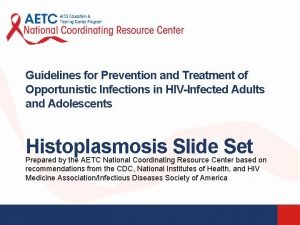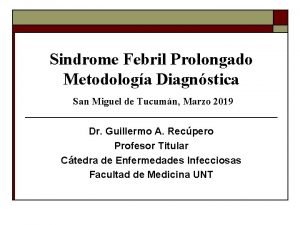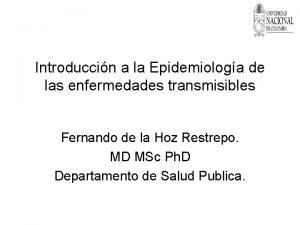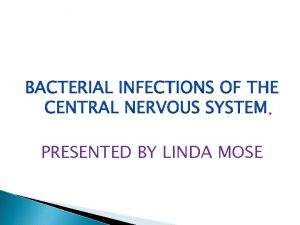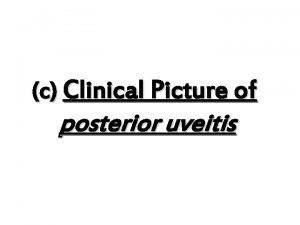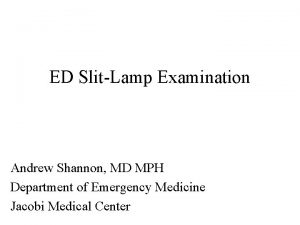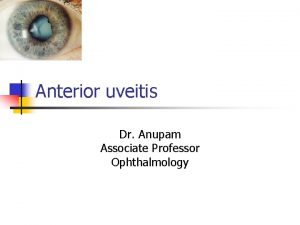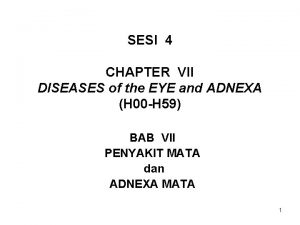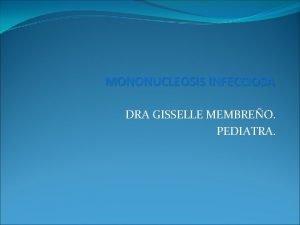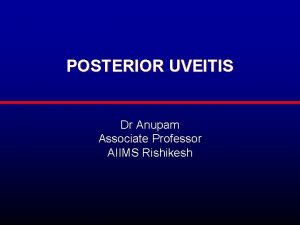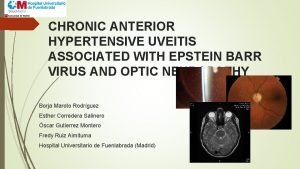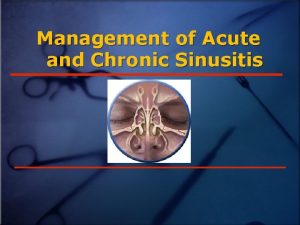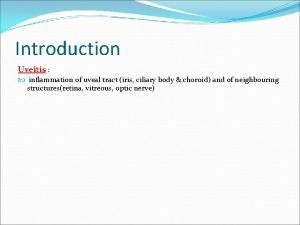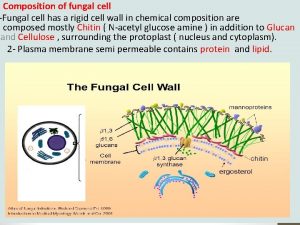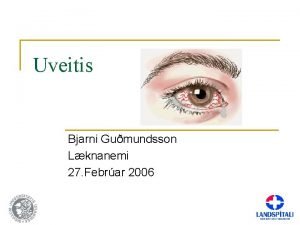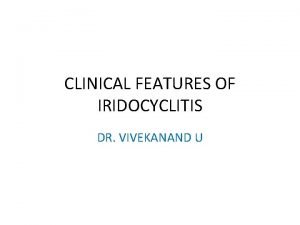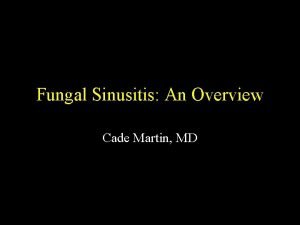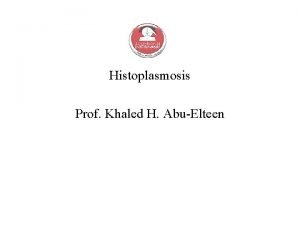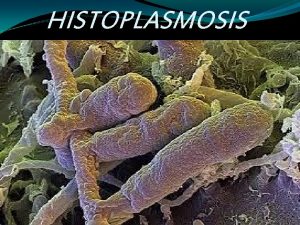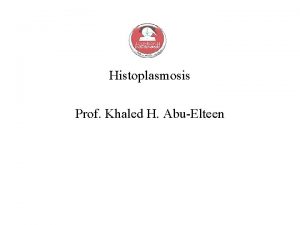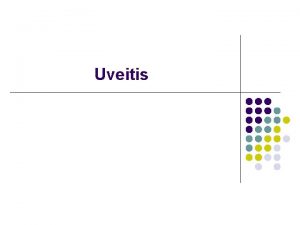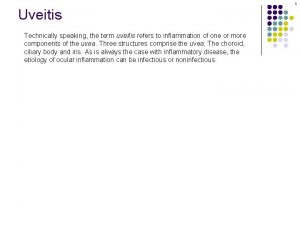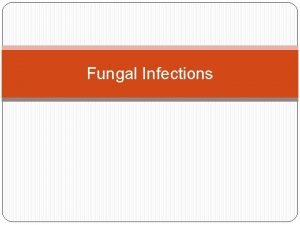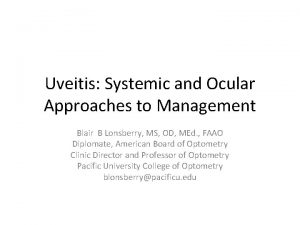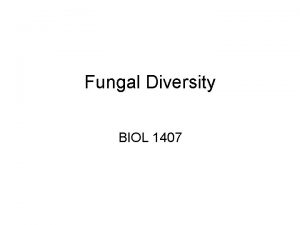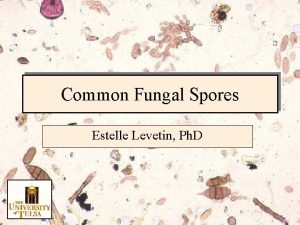Fungal Uveitis Ocular Histoplasmosis Syndrome Ocular histoplasmosis syndrome








































- Slides: 40


Fungal Uveitis

Ocular Histoplasmosis Syndrome Ocular histoplasmosis syndrome (OHS) is a multifocal chorioretinitis presumed to be due to infection with Histoplasma capsulatum.

primary infection occurs after inhalation of the fungal spores into the lungs. Ocular disease is thought to arise as a consequence of hematogenous dissemination of the organism to the spleen, liver, and choroid following the initial pulmonary infection.

Ocular histoplasmosis syndrome is most frequently found in endemic areas of the United States such as the Ohio-Mississippi River valleys, where 60% of individuals react positively to histoplasmin skin testing.

Although no serologic confirmation of histoplasmosis infection in patients with OHS has been reported, a causal relationship is strongly suggested by epidemiologic evidence linking an increased prevalence of ocular disease among patients who live or formerly resided in endemic areas.

The diagnosis of OHS is based on the clinical triad of multiple white, atrophic choroidal scars (so-called histo spots); peripapillary pigment changes; and a maculopathy due to CNV in the absence of vitreous cells.

Histo spots may appear in the macula or periphery, are discrete and punched out (arising from a variable degree of scarring in the choroid and adjacent outer retina), and are typically asymptomatic (Fig 8 -18). Figure 8 -18 Ocular histoplasmosis, atrophic histo spots.

Linear equatorial streaks can be seen in 5% of patients (Fig 8 -19). Figure 8 -19 Ocular histoplasmosis equatorial streaks.

metamorphopsia and a profound reduction in central vision herald macular involvement due to CNV and bring the patient to the attention of the ophthalmologist.

Funduscopy of active neovascular lesions reveals a yellow-green subretinal membrane surrounded by a typically pigment ring; overlying neurosensory detachment; and subretinal hemorrhage, frequently arising at the border of a histo scar in the disc-macula area.

The differential diagnosis includes entities other than age-related macular degeneration (AMD) that are frequently associated with CNV, including angioid streaks, choroidal rupture, idiopathic CNV, MCP, punctate inner choroidopathy (PIC), and granulomatous fundus lesions that may mimic the scarring seen in OHS (as in toxoplasmosis, tuberculosis, coccidioidomycosis, syphilis, sarcoidosis, and toxocariasis). The atrophic spots and maculopathy of myopic degeneration and disciform scarring in AMD may also be confused with OHS.

The early, acute granulomatous lesions of OHS are rarely observed but may be treated with oral or regional corticosteroids(Fig 8 -20). Figure 8 -20 Ocular histoplasmosis, macular choroiditis With multiple yellow elevated lesions.

In the early stages of the fluorescein angiogram (FA), foci of active choroiditis block the dye and appear hypofluorescent; later in the study.

Clinically important CNV requiring treatment includes that with membranes located 20200 µm from the foveal center (extrafoveal), that between I µm and 199 µm from the center of the foveal avascular zone (juxtafoveal), and that extending beneath the foveal center (subfoveal).

Treatment options for visionthreatening CNV include thermal laser photocoagulation (Fig 8 -21), photodynamic therapy (PDT) with verteporfin and/or intravitreal triamcinolone, submacular surgical membrane removal, and antivascular endothelial growth factor (anti-VEGF) therapy.

The Macular Photocoagulation Study (MPS) group conducted 2 multicenter, randomized, controlled clinical trials that showed a beneficial effect of argon bluegreen and krypton-red laser photocoagulation for well-defined, classic extrafoveal, juxtafoveal, and peripapillary CNV secondary to OHS.

Thermal laser photocoagulation is not used in the treatment of subfoveal CNV in the context of OHS given the profound and immediate loss of central vision that results from the destructive effects of this modality.

Photodynamic therapy with verteporfin has been advocated for the treatment of subfoveal OHS-associated CNV based on small, prospective, uncontrolled case series.

A number of anti- VEGF agents are currently being used or are in development for the treatment of neovascular AMD, including the ribonucleic acid aptamer pegaptanib (Macugen, Eyetech/pfizer, New York), approved by the Food and Drug Administration (FDA) in December 2004; ranibizumab (Lucentis, Genentech, San Francisco); the active fragment of a humanized anti- VEGF monoclonal antibody, currently in phase 3 trials; and the off-label use of the related full-length molecule, bevacizumab (Avastin, Genentech, San Francisco), approved by the FDA for the treatment of metastatic colon cancer.

A B Figure 8 -22 Ocular histoplasmosis. A, Subfoveal neovascularization. B, subfoveal neovascular membrane following submacular surgical removal.

Candidiasis Candida species are an important cause of nosocomial infections and the most common fungal organisms, causing endogenous infections of the retina, choroid, and vitreous in both the pediatric and adult populations.

Predisposing conditions associated with candidemia and the development of intraocular infection include hospitalization with a history of recent major gastrointestinal (GI) surgery, bacteria sepsis, systemic antibiotic use, indwelling catheters, hyperalimentation, debilitating diseases (eg, diabetes mellitus), immunomodulation, prolonged neutropenia, organ transplantation, or a combination of these. Hospitalized neonates and intravenous drug abusers are also at risk.

Patients may present with blurred or decreased vision due to macular chorioretinal involvement or pain arising from anterior uveitis, which may be severe. Typically, Candida chorioretinitis is characterized by multiple, bilateral, white, wellcircumscribed lesions less than 1 mm in diameter, distributed throughout the postequatorial fundus and associated with overlying vitreous cellular inflammation (Fig 8 -23). Figure 8 -23 candida retinitis

The organisms reach the eye hematogenously through metastasis to the choroid. Fungi may then break through Bruch's membrane, form subretinal abscesses, and secondarily involve the retina and vitreous.

The diagnosis of ocular candidiasis is suggested by the presence of chorioretinitis or endophthalmitis in the appropriate clinical context and confirmed by either positivc blood or vitreous cultures.

Treatment includes of intraocular intravenous administration of and candidiasis intravitreal antifungal agents. Chorioretinallesions not yet involving the vitreous body may be effectively treated with oral triazole antifungal agents fluconazole and voriconazole, a newer agent (200 mg bid for 2 -4 weeks).

Intravitreal injection of antifungal agents (amphotericin B 5 -10 µg/O. l m. L or voriconazole 100 µg/O. l m. L, with or without dexamethasone 0. 4 mg/O. l m. L) should be considered when the vitreous body is involved, usually in conjunction with pars plana vitrectomy.

Finally, intravenously administered caspofungin, a novel antifungal of the echinocandin class of cell wall inhibitors with activity against both Candida and Aspergillus, has been successfully employed in a small number of patients with Candida endophthalmitis; however, some treatment failures have also been reported with this agent.

Aspergillosis It is the second most common fungus after Calbicans to infect the retina and choroid. Individuals at risk for ocular infection include those with debilitating diseases, especially chronic pulmonary disease, endocarditis, and cancer, and intravenous drug abusers.

Aspergillus infection of the eye presents with unilateral or bilateral vitritis, fluffyvitreous exudates, and yellow-white subretinal and retinal infiltrates similar to those seen with candidal infections, frequently involving the posterior pole and macula (Fig 8 -25 A). Figure 8 -25 A, Subhyaloidal hypopyon due to endogenous Aspergillus endophthalmitis in an immunocompetent patient.

In contrast to the lesions associated with Candida chorioretinitis and endophthalmitis, those produced by Aspergillus species are larger and more likely to be hemorrhagic, and they commonly invade the retinal and choroidal vessels, which may result in broad areas of ischemic infarction.

The diagnosis requires a high degree of suspicion within the correct clinical context and is confirmed by the demonstration of septate, dichotomously branching hyphae on analysis of vitreous fluid specimens. Aspergillus may be difficult to culture from the blood.

As with other cases of endogenous endophthalmitis, therapy both and systemic requires intraocular antifungal therapy, together with diagnostic and therapeutic pars plana vitrectomy.

Cryptococcosis Cryptococcus neoformans is yeast that is found in contaminated soil and in pigeon feces in high concentrations worldwide. Infection is acquired through inhalation of the aerosolized fungus. It has a predilection for the central nervous system and may produce severe disseminated disease among immunomodulated or debilitated patients.

Although overall it remains an uncommon disease, cryptococcosis is the most common cause of fungal meningitis, as well as the most frequent fungal eye infection in patients with HIV /AIDS.

The fungus probably hematogenously; reaches however, the eye frequent association of ocular cryptococcosis with meningitis suggests that ocular infection may result from a direct extension from the optic nerve. Ocular infections may occur months after the onset of meningitis or, in rare instances, before the onset of clinically apparent central nervous system disease.

The most frequent presentation of ocular cryptococcosis is multi focal chorioretinitis, which appears as solitary or multiple discrete yellowwhite lesions varying markedly in size in the postequatorial fundus. Associated findings include variable degrees of vitritis, vascular sheathing, papilledema, exudative and cellular inflammation. retinal detachment, granulomatous anterior

The clinical diagnosis requires a high degree of suspicion and is supported by demonstration of the organism with India ink stains or by culture of the fungus from cerebrospinal fluid.

 Candida uveitis
Candida uveitis Histoplasmosis treatment
Histoplasmosis treatment Histoplasmosis ganglionar
Histoplasmosis ganglionar Fiebre ondulante
Fiebre ondulante Microparasitos y macroparasitos
Microparasitos y macroparasitos In what situation should a nail service not be performed
In what situation should a nail service not be performed Fungal nutrition
Fungal nutrition There's a fungus among us origin
There's a fungus among us origin Icd 10 miopia
Icd 10 miopia Juvenile rheumatoid arthritis symptoms
Juvenile rheumatoid arthritis symptoms Csf meningitis
Csf meningitis Posterior uveitis
Posterior uveitis Fungal spores
Fungal spores Uveitis
Uveitis Polymorphs pour out to sink to bottom of anterior chamber
Polymorphs pour out to sink to bottom of anterior chamber Iridocyclitia
Iridocyclitia Uveitis
Uveitis Uvea
Uvea Imdirecta
Imdirecta Toxocara
Toxocara Purulent uveitis
Purulent uveitis Kingdom fungi cell wall
Kingdom fungi cell wall Hypertensive uveitis
Hypertensive uveitis Granulomatous uveitis
Granulomatous uveitis Allergic fungal sinusitis treatment
Allergic fungal sinusitis treatment Uveitis
Uveitis Xenospores
Xenospores Muddy iris in uveitis
Muddy iris in uveitis Single celled fungi
Single celled fungi Fungi 3 examples
Fungi 3 examples Fungal reproduction
Fungal reproduction Milady nail diseases and disorders
Milady nail diseases and disorders Sjónhimnulos
Sjónhimnulos Enfermedad de birdshot
Enfermedad de birdshot Phyla
Phyla Esclerouveitis
Esclerouveitis Occlusio pupillae seclusio pupil
Occlusio pupillae seclusio pupil Black snot
Black snot Vagabundeo ocular
Vagabundeo ocular Metamorphopsis
Metamorphopsis Chorda tympani
Chorda tympani

